
Lavandula stoechas, the Spanish lavender or topped lavender (U.S.) or French lavender (U.K.), is a species of flowering plant in the family Lamiaceae, occurring natively in several Mediterranean countries, including France, Spain, Portugal, Italy, Turkey and Greece.

Rebutia is a genus of flowering plants in the family Cactaceae, native to Bolivia and Argentina. They are generally small, colorful cacti, globular in form, which freely produce flowers that are relatively large in relation to the body. They have no distinctive ribs, but do have regularly arranged small tubercles. They are considered fairly easy to grow and they may produce large quantities of seeds that germinate freely around the parent plant.

Mammillaria rhodantha, the rainbow pincushion, is a plant in the cactus family (Cactaceae) and is one of 171 species in the genus Mammillaria which are characterized by having nipple-shaped tubercles or prominences on their surface.

Mammillaria spinosissima, also known as the spiny pincushion cactus, is a species of flowering plant in the cactus family Cactaceae, endemic to the central Mexican states of Guerrero and Morelos, where they grow at elevations of approximately 1,600 to 1,900 metres. The species was described in 1838 by James Forbes, gardener of the Duke of Bedford. Botanist David Hunt collected a specimen in 1971, when he located one near Sierra de Tepoztlan, Mexico.

Parodia magnifica is a species of flowering plant in the family Cactaceae, native to southern Brazil. One of several species called ball cactus, it grows to 7–15 cm (3–6 in) tall by 45 cm (18 in) broad, with heavily ribbed, spherical to columnar, spiny and hairy stems, bearing pale yellow flowers in summer. Its natural habitat is cool, dry temperate grassland at elevations of up to 800 m (2,600 ft). Populations are sparse and fragmented, and it has been designated as “Endangered” by the IUCN Red List.

Rebutia minuscula is a species of cactus from South America found in northern Argentina and Bolivia. It is the type species of the genus Rebutia. As its synonym Rebutia senilis it has gained the Royal Horticultural Society’s Award of Garden Merit. Its cultivars 'Krainziana', 'Marsoneri' and 'Violaciflora' are also listed as having gained the Award of Garden Merit.

Parodia scopa, the silver ball cactus, is a species of flowering plant in the cactus family Cactaceae, native to upland southern Brazil and Uruguay. It is a ball- or cylinder-shaped cactus growing to 5–50 cm (2–20 in) tall by 10 cm (4 in) broad, with a spiny, woolly crown and pale yellow flowers in summer.
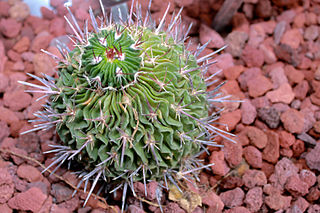
Stenocactus multicostatus, the brain cactus, is a member of the cactus family native to the deserts of Mexico, and is popular in the gardening community. It has gained the Royal Horticultural Society's Award of Garden Merit. Though it has only been reported in the shrublands of Chihuahua, Coahuila, Durango, Nuevo León, San Luis Potosí, Zacatecas, and Tamaulipas, it has yet to be assessed using the IUCN Categories and Criteria because its taxonomy is still unclear.

Thelocactus bicolor, the glory of Texas, is a species of flowering plant in the cactus family, widely distributed in the northern Chihuahuan Desert of the USA (Texas) and Mexico. Plants are usually solitary, but may form clumps. Growing to 50 cm (20 in) tall, it is a perennial with spiny, ribbed, succulent stems. Large daisy-like flowers, up to 8 cm (3.1 in) in diameter, are borne in summer. The petals are purplish-pink, fading to white. The inner petal tips form a circle of red surrounding a prominent yellow boss.
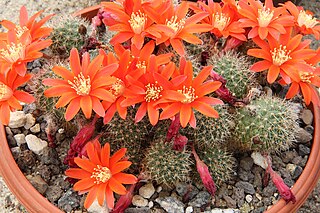
Rebutia fiebrigii, the orange crown cactus or flame crown, is a species of flowering plant in the cactus family that is native to exposed rocky plateaux in the Bolivean Andes, at altitudes of 2,100–4,000 m (6,900–13,100 ft) above sea level. It consists of a solitary ball some 15 cm (5.9 in) in diameter, covered in tubercles and silky hairs, with brilliant orange daisy-like flowers. In time these balls multiply to form mounds.

Copiapoa hypogaea, the underground copiapoa, is a species of flowering plant in the genus Copiapoa in the cactus family (Cactaceae), native to northern Chile. It has gained the Royal Horticultural Society's Award of Garden Merit.

Matucana intertexta is a species of cactus in the genus Matucana, native to Peru. It has gained the Royal Horticultural Society's Award of Garden Merit.
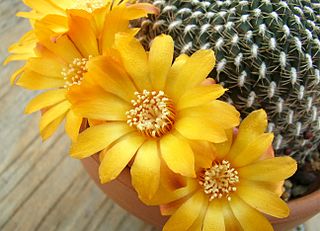
Rebutia arenacea, the arenaceous crown cactus, is a species of cactus in the genus Rebutia, native to central Bolivia. It has gained the Royal Horticultural Society's Award of Garden Merit.
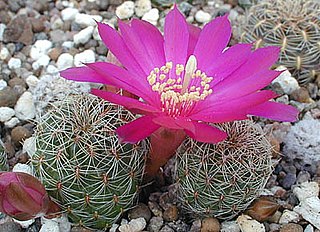
Rebutia canigueralii is a species of cactus in the genus Rebutia, native to Bolivia. It has gained the Royal Horticultural Society's Award of Garden Merit.

Rebutia mentosa, the crown cactus, is a species of cactus in the genus Rebutia, native to Bolivia. It has gained the Royal Horticultural Society's Award of Garden Merit.

Rebutia pulvinosa is a species of cactus in the genus Rebutia, native to Bolivia. Two of its subspecies, Rebutia pulvinosa subsp. albiflora and Rebutia pulvinosa subsp. perplexa, have gained the Royal Horticultural Society's Award of Garden Merit.
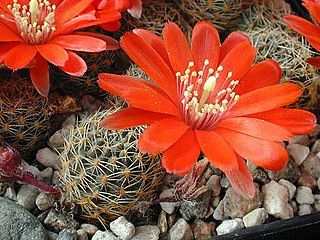
Rebutia pygmaea is a species of cactus in the genus Rebutia, native to Bolivia and northwest Argentina. It has gained the Royal Horticultural Society's Award of Garden Merit.

Rebutia steinbachii, called Steinbach's crown cactus, is a species of cactus in the genus Rebutia, native to Bolivia. It has gained the Royal Horticultural Society's Award of Garden Merit.

Echinopsis arachnacantha is a species of cactus in the genus Echinopsis, native to Bolivia. It has gained the Royal Horticultural Society's Award of Garden Merit.

Disocactus speciosus, the sun cactus, is a species of flowering plant in the family Cactaceae. It is native to Mexico, Honduras and Guatemala, and has been introduced to the Canary Islands. As its synonym Heliocereus speciosus it has gained the Royal Horticultural Society's Award of Garden Merit.




















